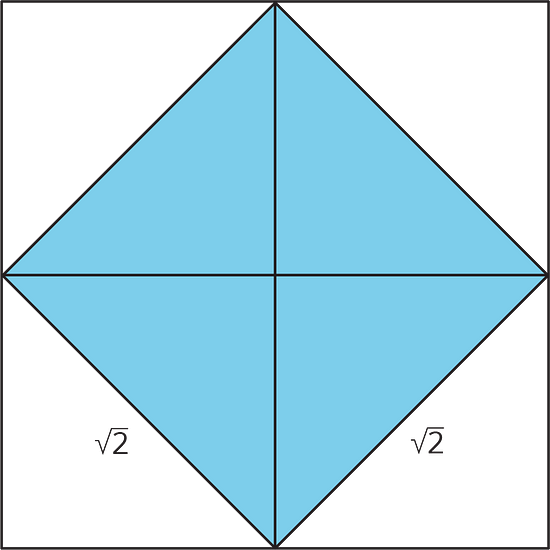Lesson 3Rational and Irrational Numbers
Let’s learn about irrational numbers.
Learning Targets:
- I know what a rational number is and can give an example.
- I know what an irrational number is and can give an example.
3.1 Algebra Talk: Positive Solutions
Find a positive solution to each equation:
3.2 Three Squares

-
Draw 3 squares of different sizes with vertices aligned to the vertices of the grid.
-
For each square:
-
Label the area.
-
Label the side length.
-
Write an equation that shows the relationship between the side length and the area.
-
3.3 Looking for a Solution
Are any of these numbers a solution to the equation ? Explain your reasoning.
-
1
-
-
-
3.4 Looking for
A rational number is a fraction or its opposite (or any number equivalent to a fraction or its opposite).
- Find some more rational numbers that are close to .
- Can you find a rational number that is exactly ?
Are you ready for more?
If you have an older calculator evaluate the expressionand it will tell you that the answer is 2, which might lead you to think that .
- Explain why you might be suspicious of the calculator’s result.
-
Find an explanation for why could not possibly equal . How does this show that could not equal 2?
- Repeat these questions foran equation that even many modern calculators and computers will get wrong.
Lesson 3 Summary
In an earlier activity, we learned that square root notation is used to write the length of a side of a square given its area. For example, a square whose area is 2 square units has a side length of units, which means that

A square whose area is 25 square units has a side length of units, which means that Since , we know that
is an example of a rational number. A rational number is a fraction or its opposite. Remember that a fraction is a point on the number line found by dividing the segment from 0 to 1 into equal intervals and going of those intervals to the right of 0. We can always write a fraction in the form where and are whole numbers (and is not 0), but there are other ways to write them. For example, we can write . You first learned about fractions in earlier grades, and at that time, you probably didn't know about negative numbers. Rational numbers are fractions, but they can be positive or negative. So, -5 is also a rational number. Because fractions and ratios are closely related ideas, fractions and their opposites are called RATIOnal numbers.
An irrational number is a number that is not rational. That is, it is a number that is not a fraction or its opposite. is an example of an irrational number. It has a location on the number line, and its location can be approximated by rational numbers (it's a tiny bit to the right of ), but can not be found on a number line by dividing the segment from 0 to 1 into equal parts and going of those parts away from 0 (if and are whole numbers).

is also close to , because . is very close to 2, since . But we could keep looking forever for solutions to that are rational numbers, and we would not find any. is not a rational number! It is irrational.
In your future studies, you may have opportunities to understand or write a proof that is irrational, but for now, we just take it as a fact that is irrational. Similarly, the square root of any whole number is either a whole number (, , etc.) or irrational (, , etc.). Here are some other examples of irrational numbers:
Glossary Terms
An irrational number is a number that is not a fraction or the opposite of a fraction.
Pi () and are examples of irrational numbers.
A rational number is a fraction or the opposite of a fraction.
Some examples of rational numbers are:
Lesson 3 Practice Problems
Decide whether each number in this list is rational or irrational.
Which value is an exact solution of the equation ?
-
7
-
-
3.74
-
-
A square has vertices , and . Which of these statements is true?
-
The square’s side length is 5.
-
The square’s side length is between 5 and 6.
-
The square’s side length is between 6 and 7.
-
The square’s side length is 7.
-
Rewrite each expression in an equivalent form that uses a single exponent.
The graph represents the area of arctic sea ice in square kilometers as a function of the day of the year in 2016.
- Give an approximate interval of days when the area of arctic sea ice was decreasing.
- On which days was the area of arctic sea ice 12 million square kilometers?
The high school is hosting an event for seniors but will also allow some juniors to attend. The principal approved the event for 200 students and decided the number of juniors should be 25% of the number of seniors. How many juniors will be allowed to attend? If you get stuck, try writing two equations that each represent the number of juniors and seniors at the event.